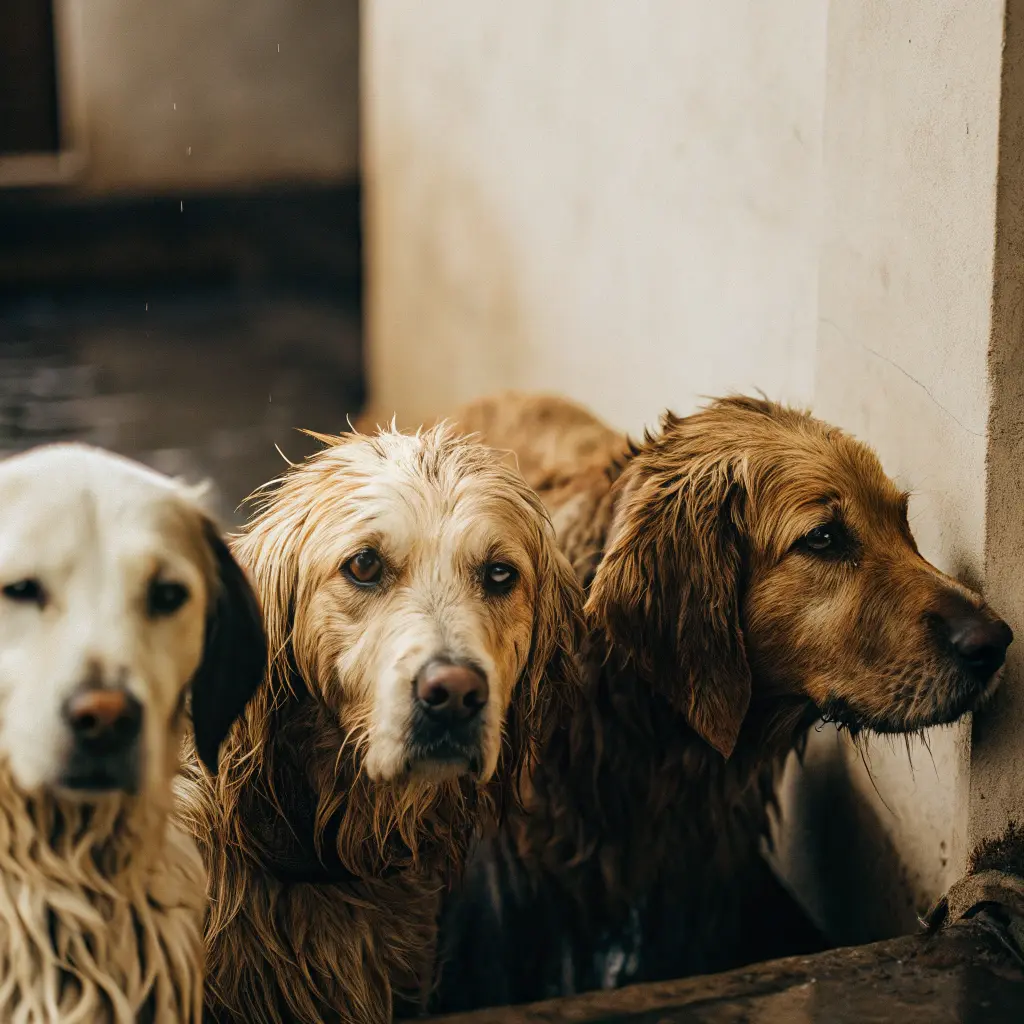Can Dogs Get the Flu from Humans?
As flu season approaches, many pet owners wonder if they can transmit the illness to their furry friends. The thought of your dog contracting the flu can be unsettling, especially if you’re already battling the virus.
Understanding the risks and taking necessary precautions is crucial to keeping your dog safe and healthy. So, can dogs get the flu from humans? Let’s explore this question and what it means for you and your pet.
Table of Contents
Table of Contents
Key Takeaways
- Dogs can contract a type of flu, but it’s not the same as the human flu virus.
- There is not much chance of human-to-dog transfer.
- Precautions can be taken to minimize the risk of transmission.
- Symptoms in dogs can be similar to those in humans, including coughing and lethargy.
- If you have the flu, it’s essential to take steps to protect your dog.

The Science Behind Human-to-Dog Flu Transmission
Delving into the science of human-to-dog flu transmission reveals the intricate dynamics of influenza viruses and their potential to cross species barriers. As a dog owner, understanding this complex topic can help you better protect your pet.
Influenza viruses are categorized into different types, with some being more relevant to human-to-dog transmission than others.
Different Types of Influenza Viruses
Influenza viruses are primarily classified into three types: A, B, and C. Type A and B viruses are known to cause seasonal epidemics in humans, while Type C viruses typically cause mild infections.
Human Influenza Strains
Human influenza strains, particularly Type A and B, are well-adapted to human hosts. However, the possibility of these strains transmitting to dogs is a subject of scientific study.
Canine Influenza Strains
Canine influenza strains, on the other hand, are specifically adapted to dogs. These strains, also Type A, have been known to cause outbreaks in dog populations.
How Viruses Cross Species Barriers
The crossing of species barriers by influenza viruses involves complex interactions between the virus and the host cells of different species. Research has shown that certain conditions can facilitate this cross-species transmission, although the frequency and circumstances under which this occurs are still being studied.
Understanding the science behind influenza viruses and their potential for human-to-dog transmission can help you take informed steps to protect your dog. While the risk is still being researched, being aware of the factors involved can guide your actions.
Can Dogs Get the Flu from Humans? What Research Shows
Research into the transmission of the flu between humans and dogs has been ongoing, with significant studies shedding light on this issue. The key to understanding this transmission lies in examining the scientific evidence and documented cases.
Scientific Studies on Cross-Species Transmission
Several scientific studies have explored the possibility of cross-species transmission of the flu. These studies typically involve analyzing the genetic makeup of influenza viruses found in dogs and comparing them to human strains.
Research published in veterinary journals has indicated that certain strains of the flu can indeed be transmitted between humans and dogs, although the frequency and circumstances of such transmission are still being studied.
Documented Cases and Evidence
There have been documented cases where dogs have contracted the flu, with evidence suggesting that these cases were linked to human influenza outbreaks.
For instance, during significant flu outbreaks, some dogs have tested positive for the flu virus, with genetic analysis confirming that the strain was similar to the one circulating among humans.
These findings underscore the need for vigilance and further research into preventing such transmissions. By understanding the scientific basis of flu transmission between humans and dogs, pet owners can take informed steps to protect their pets during flu season.
How to Identify Flu Symptoms in Your Dog
If you’re wondering whether your dog has caught the flu, it’s essential to know the common signs of canine influenza. As a responsible dog owner, being aware of these symptoms can help you take prompt action to ensure your pet receives the necessary care.
Common Signs of Canine Influenza
Canine influenza manifests through various symptoms, which can be broadly categorized into respiratory and behavioral changes.
Respiratory Symptoms
Respiratory symptoms are among the most common signs of flu in dogs. These include:
- Coughing
- Sneezing
- Nasal discharge
- Rapid breathing
Behavioral Changes
In addition to respiratory symptoms, dogs with the flu may exhibit behavioral changes, such as:
- Lethargy
- Loss of appetite
- Depression

Differentiating Flu from Other Canine Illnesses
It’s crucial to differentiate canine influenza from other illnesses that may present similar symptoms. A thorough examination by a veterinarian, along with diagnostic tests, can help determine the exact cause of your dog’s symptoms.
| Symptom | Canine Influenza | Other Canine Illnesses |
| Coughing | Common | Can be present in kennel cough, pneumonia |
| Lethargy | Common | Can be present in various infections, cancer |
| Nasal Discharge | Common | Can be present in sinus infections, allergies |
Step-by-Step Guide to Monitoring Your Dog’s Health
Monitoring your dog’s health is a vital part of ensuring they lead a happy and healthy life. Regular checks can help you identify any potential issues early on, allowing for timely intervention.
Creating a Daily Health Check Routine
Establishing a daily health check routine is essential for maintaining your dog’s wellbeing. Start by observing your dog’s behavior, appetite, and energy levels. Look for any changes or signs of illness, such as coughing, sneezing, or lethargy. Make it a habit to check your dog’s temperature daily, especially during flu season, as dogs can contract the flu virus.
Using a Temperature Log and Symptom Tracker
Keeping a temperature log and symptom tracker can be incredibly helpful. Record your dog’s temperature daily and note any symptoms or changes in behavior. This log can be invaluable when consulting with your veterinarian, providing a clear picture of your dog’s health over time. It’s a simple yet effective way to stay on top of your dog’s health and catch any potential issues early.
By following these steps and maintaining a consistent health check routine, you can help ensure your dog remains healthy and happy. Regular monitoring, combined with a keen eye for detail, is key to effective dog health monitoring.
Protecting Your Dog When You’re Sick: A Complete Protocol
When you’re under the weather, it’s crucial to take steps to protect your dog from getting sick. Protecting your dog from the flu starts with understanding the risks and taking proactive steps when you’re under the weather. This involves a combination of good hygiene practices, safe separation techniques, and monitoring your dog’s health closely.
Essential Hygiene Practices to Prevent Transmission
To prevent the transmission of the flu to your dog, maintaining good hygiene is paramount. This includes practices such as proper hand washing and sanitizing, as well as cleaning shared spaces and items.
Hand Washing and Sanitizing Techniques
Washing your hands frequently with soap and water is one of the most effective ways to prevent the spread of the flu virus. Use an alcohol-based hand sanitizer when soap and water are not available. Ensure you wash your hands before and after interacting with your dog.
Cleaning Shared Spaces and Items
Regularly clean and disinfect surfaces and items that you and your dog come into contact with. This includes doorknobs, remote controls, and your dog’s food and water bowls. Use a pet-safe disinfectant to avoid harming your dog.
Creating Safe Separation Without Causing Stress
While it’s essential to separate yourself from your dog when you’re sick to prevent transmission, it’s equally important to do this without causing your dog undue stress. You can achieve this by maintaining a routine and ensuring your dog has a comfortable, quiet space.
By following these steps and being mindful of your hygiene and interaction with your dog, you can significantly reduce the risk of transmitting the flu to your dog.
What to Do If You Suspect Your Dog Has Caught the Flu
When your dog shows signs of the flu, taking immediate action is crucial for their recovery and well-being. The flu can lead to serious complications, so it’s vital to be proactive.
Immediate Home Care Steps
As soon as you suspect your dog has the flu, there are several steps you can take at home to help them feel better.
Hydration and Comfort Measures
Ensuring your dog stays hydrated is crucial. Offer plenty of fresh water, and consider adding a little warm water to their food to make it more appealing. You can also give them a peaceful, cozy place to sleep.
Isolation from Other Pets
To prevent the spread of the flu to other pets, isolate your dog as much as possible. This means keeping them in a separate room and avoiding contact with other animals in the household.
When and How to Contact Your Veterinarian
If your dog is showing symptoms of the flu, it’s essential to contact your veterinarian for guidance. Prepare a list of symptoms and any questions you have to discuss with them.
“If your dog is experiencing difficulty breathing, persistent coughing, or a high fever, seek immediate veterinary care.”
Your veterinarian can provide advice on the best course of action and whether your dog needs to be seen. In certain situations, they might suggest antiviral treatment or supportive care.
| Symptom | Action |
| Coughing, sneezing | Monitor symptoms, provide comfort |
| Difficulty breathing | Seek immediate veterinary care |
| Loss of appetite | Encourage eating with warm, appealing food |

Comprehensive Treatment Guide for Dogs with Influenza
Treating canine influenza requires a multi-faceted approach that involves both veterinary care and home care. As a dog owner, it’s crucial to understand the various treatment options available to help your dog recover from the flu.
Veterinary Treatment Options
Veterinary treatment is a critical component of treating canine influenza. Your veterinarian may prescribe various treatments based on the severity of your dog’s condition.
Medications and Their Administration
To treat secondary bacterial infections, your veterinarian could recommend antibiotics or antiviral drugs. It’s essential to follow the prescribed dosage and administration instructions carefully to ensure your dog’s safe recovery.
Follow-up Care Protocol
A follow-up care protocol is vital to monitor your dog’s progress and adjust the treatment plan as needed. This may include regular check-ups with your veterinarian and ongoing monitoring of your dog’s symptoms.
Creating a Healing Environment at Home
In addition to veterinary care, creating a healing environment at home can help your dog recover from the flu. This includes providing a comfortable and quiet space for your dog to rest, ensuring they stay hydrated, and maintaining a nutritious diet.
By combining dog flu treatment with proper home care, you can help your dog recover from the flu and prevent complications.
How to Build a Preventative Care Plan for Your Dog
To keep your dog healthy and thriving, developing a preventative care plan is key. A comprehensive plan not only protects your dog from illnesses but also enhances their overall quality of life. As a dog owner, understanding the components of a preventative care plan is crucial.
Vaccination Options and Schedules
Vaccinations play a vital role in protecting your dog from infectious diseases. The core vaccines, which include rabies, distemper, and parvovirus, are recommended for all dogs. Non-core vaccines are given based on your dog’s lifestyle and exposure risk. Consult with your veterinarian to determine the best vaccination schedule for your dog.
| Vaccine Type | Recommended For | Booster Schedule |
| Core Vaccines | All dogs | Every 1-3 years |
| Non-Core Vaccines | Dogs at risk | As recommended by vet |
Immune-Boosting Diet and Supplement Strategies
A well-balanced diet rich in essential nutrients is fundamental to your dog’s health. Consider adding supplements that support immune function, such as omega-3 fatty acids and antioxidants. Before altering your dog’s diet, always get advice from your veterinarian.
- Feed a high-quality, nutrient-rich dog food.
- Consider adding omega-3 supplements.
- Include antioxidant-rich foods or supplements.
By combining a thoughtful vaccination strategy with a nutrient-rich diet, you can significantly enhance your dog’s health and resilience against diseases.
Special Care Instructions for High-Risk Dogs
Certain canine populations are more susceptible to the flu, necessitating tailored care strategies. High-risk dogs include puppies, senior dogs, and those with pre-existing health conditions. Understanding the specific needs of these groups is crucial for effective care.
Tailored Approaches for Puppies and Senior Dogs
Puppies and senior dogs have weaker immune systems, making them more vulnerable to the flu. For puppies, it’s essential to limit exposure to potential flu carriers until they’ve received their full vaccination series. Senior dogs benefit from a comfortable, stress-free environment that supports their immune system. Monitoring their health closely and maintaining a clean living space are critical steps in flu prevention.
Supporting Dogs with Pre-existing Conditions
Dogs with pre-existing health conditions require extra care during flu season. Managing their condition effectively and taking precautions to avoid flu exposure are vital. Consult with your veterinarian to develop a comprehensive care plan that addresses both their ongoing health needs and flu prevention. A Their immune system can also be strengthened by eating a balanced diet and getting regular exercise.
| High-Risk Group | Care Strategies |
| Puppies | Limit exposure, complete vaccinations, monitor health closely |
| Senior Dogs | Provide a stress-free environment, maintain cleanliness, monitor health |
| Dogs with Pre-existing Conditions | Manage their condition, avoid flu exposure, healthy diet, appropriate exercise |
Conclusion: Balancing Vigilance with Peace of Mind
As a dog owner, understanding the risks of dog flu transmission from humans is crucial for protecting your pet. By being aware of the signs and symptoms, you can take proactive steps towards dog flu prevention. This includes maintaining good hygiene practices, monitoring your dog’s health closely, and seeking veterinary care when necessary.
While it’s essential to be vigilant, it’s equally important to have peace of mind. By following the guidelines outlined in this article, you can significantly reduce the risk of your dog contracting the flu. This allows you to enjoy quality time with your pet without undue worry, knowing you’ve taken the necessary precautions to keep them safe and healthy.
Ultimately, balancing vigilance with peace of mind is key to ensuring your dog’s well-being. Stay informed, be proactive, and trust your instincts as a dog owner to provide the best possible care for your furry friend.
FAQ
Can dogs catch the flu from humans?
While dogs can contract canine influenza, the risk of catching the flu directly from humans is relatively low. However, it’s still crucial to take precautions to prevent transmission.
Can dogs get the flu?
Yes, dogs can get infected with canine influenza, a type of flu specifically affecting dogs. It’s essential to monitor your dog’s health and watch for symptoms.
Can dogs get colds?
Dogs can catch colds, but the viruses that cause colds in humans are different from those that affect dogs. However, dogs can still get respiratory infections.
Can dogs catch the cold from humans?
The likelihood of dogs catching a cold from humans is low, as the viruses are different. Still, it’s crucial to maintain good hygiene practices to prevent the spread of illness.
How to tell if a dog is cold?
Check for signs such as shivering, lethargy, or a decrease in appetite. If you suspect your dog is cold, provide a warm and comfortable environment.
What are the symptoms of canine influenza in dogs?
Common symptoms include coughing, sneezing, runny eyes, and lethargy. If you notice these signs, consult with your veterinarian for proper diagnosis and treatment.
How can I protect my dog from getting the flu?
Maintain good hygiene, keep your dog up-to-date on vaccinations, and avoid close contact with your dog when you’re sick to minimize he risk of transmission.

